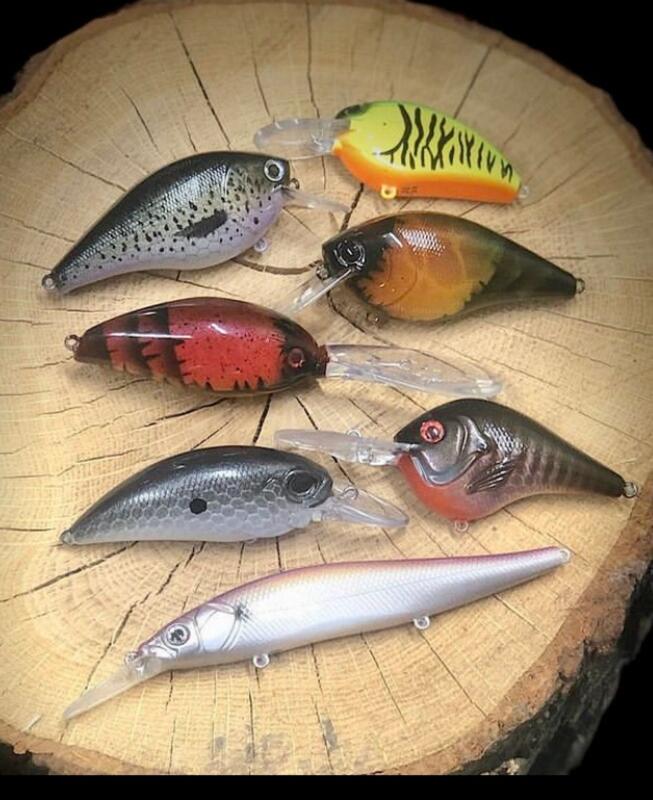A sample of the varied styles of lures painted by Dustin Smart. (Submitted photo)
If necessity was the Mother of Invention, then who’s the Father of Hand-craft?
I don’t know, but I’m confident the death of self-created works was low-cost, high-volume, consumer culture wrapped in marketing and destined for the landfill.
Despite the bombardment of ads everywhere and all the time, craft persists. Practical creations from one’s own hands are ancient, existing from time immemorial.
A pair of lures made by Dustin Smart in the painting process. (Submitted photo)
Craft is on display in grandpa’s workshop, the cousin’s kitchen and the farmers market. Hand-craft also is found on the water, by the hands of anglers. Handmade fishing paraphernalia isn’t relegated to nostalgic paintings and antique stores. Anglers among us envision and build functional works of art with one eye toward the avocation and one eye toward aesthetics.
One such practical artist is Tony Nicol of rural Solon. A particularly memorable experience with his handcraft was on a wild river in the west. He was in pursuit of the Wyoming Cutt-slam — to catch four cutthroat trout in their native haunts. The location was too remote to just go to the store and buy flies that matched what the local trout wanted.
Dustin Smart’s rendition of a baby bass. (Submitted photo)
Not a problem. Tony broke out his fly tying kit and whipped up a satisfactory imitation to find success on the water. Tony observed the trout on that stretch of river wanted a type of mayfly: something fat and gray, with an “emerging” pattern; a confident deduction that only comes from years of experience.
Local angler Dustin Smart of North Liberty used COVID lock-down boredom to inspire his turn to hand-crafted lures. Dustin explained how he found some unfinished automobile scale-models from his middle school days. To finally complete the work he bought an airbrush.
Quickly though his thoughts turned to fishing and his realization that if he could paint replica cars then he could probably paint fish patterns on hard body crankbaits. The avid angler considered the cost of store-bought crankbaits and figured he could have fun and save a little money if he did them himself. He’s been doing both ever since.
Angling craft isn’t limited to lures any more than craft is limited to fishing. Handmade landing nets and fishing rods are likely craft. Some hunters have forged their own knives or embellished the gunstock. Handmade snowshoes and artfully knitted caps add to the enjoyment of the season.
A close up of an Elk hair caddis creation by Tony Nichol. (Submitted photo)
In our area, classes abound. County conservation boards host builder workshops, Vesterheim in Decorah will teach knifemaking and knitting. Community colleges offer a host of enrichment courses. Someone at work or church is bound to practice a practical craft, an earnest inquiry may be all it takes to join in.
A showy black creation by Tony Nichol called a Leech-pattern streamer. (Submitted photo)
I’ll be looking to learn sewing. If I piece together the salvageable parts of the various items of camo I own, then I’m bound to create a one-of-a-kind garment to help me disappear.
Smart takes the blank canvas of a plain, hard-plastic crankbait and applies water-based acrylic paints with a sealing coat to create lures that not only catch the eye but catch fish, too.
When asked, Dustin said his most memorable use of his own lures was the first time. He and his father were fishing Mille Lacs. The smallmouth bass were playing hard to get until his father asked to use one of the “red” lures. Dustin said his dad made two-to-three casts and “boom.” Dustin tied on another copy and the rest of the outing was a frenzy of fish catching on the big lake.
Tony flyfishes almost exclusively with flies of his own creation. His passion is the dry fly, even if that means forgoing other methods that may be more effective on a given day, like streamers or nymphs. The dry fly gently rests on the water’s surface. It imitates an underwater insect that has just swam to the surface to hatch wings and then fly away.
When a particular type of fly is hatching in the stream, the trout key in on that insect to the exclusion of perfectly fine lures imitating different flies. Therefore a fly angler needs to “match the hatch” to catch fish through deception.
About 25 years ago on an Iowa trout stream, Tony found himself unable to match the tiny olive-colored insects taking wing. His frustrating search for commercially available imitations inspired him to tie his own version on a minuscule #22 hook. Ever since, he’s refined his craft and expanded his collection.
“There’s nothing like catching a trout on your own fly,” he said. “The satisfaction you get from that is unbelievable.”
He recommends the craft. While it does demand patience, he said “putting on music, getting into the groove, is so relaxing.”
If you don’t have the equipment to paint your own lures then you can order one from Dustin. Once his friends took notice of his bespoke lures, they naturally wanted their own to the point he opened an Instagram account to sell his works @hawkeye_custom_lures.
The lure painted like Eddie Van Halen’s guitar is my favorite.
There’s still time to make something for winter. If not, then how about a carved walking stick for morel mushroom season? From my investigations, whatever it is you enjoy under the stars and sun, will be all the more richer an experience with your own contribution to the craft.
Looking up, looking ahead, and keeping my pencil sharp.
John Lawrence Hanson, Ed.D., of Marion, teaches U.S. history with an emphasis on environmental issues at Linn-Mar High School and is past president of the Linn County Conservation Board
Credit: Source link





























